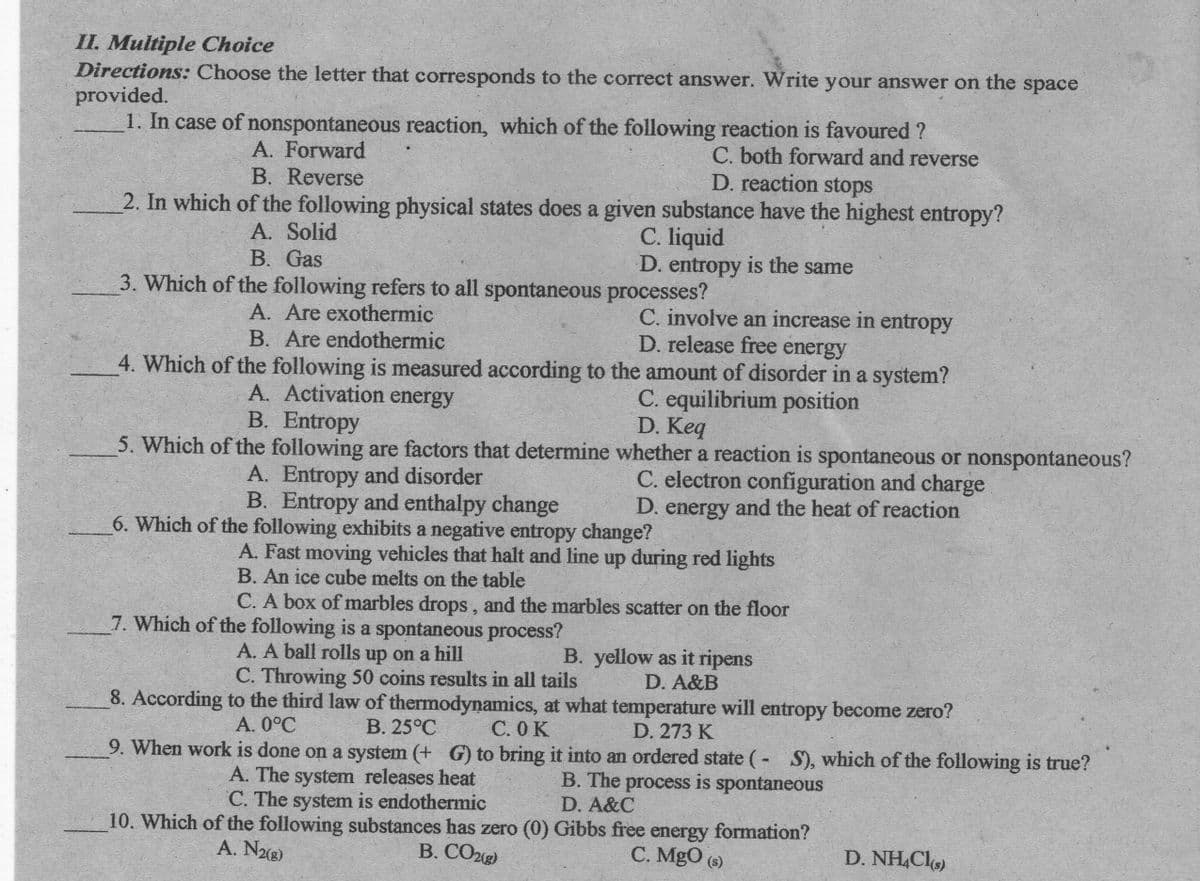Directions: Choose the letter that corresponds to the correct answer. Write your answer on the space provided. 1. In case of nonspontaneous reaction, which of the following reaction is favoured ? A. Forward B. Reverse C. both forward and reverse D. reaction stops 2. In which of the following physical states does a given substance have the highest entropy? A. Solid В. Gas C. liquid D. entropy is the same 3. Which of the following refers to all spontaneous processes? A. Are exothermic B. Are endothermic C. involve an increase in entropy D. release free energy 4. Which of the following is measured according to the amount of disorder in a system? A. Activation energy B. Entropy C. equilibrium position D. Keq 5. Which of the following are factors that determine whether a reaction is spontaneous or nonspontaneous?
Directions: Choose the letter that corresponds to the correct answer. Write your answer on the space provided. 1. In case of nonspontaneous reaction, which of the following reaction is favoured ? A. Forward B. Reverse C. both forward and reverse D. reaction stops 2. In which of the following physical states does a given substance have the highest entropy? A. Solid В. Gas C. liquid D. entropy is the same 3. Which of the following refers to all spontaneous processes? A. Are exothermic B. Are endothermic C. involve an increase in entropy D. release free energy 4. Which of the following is measured according to the amount of disorder in a system? A. Activation energy B. Entropy C. equilibrium position D. Keq 5. Which of the following are factors that determine whether a reaction is spontaneous or nonspontaneous?
Chemistry for Engineering Students
4th Edition
ISBN:9781337398909
Author:Lawrence S. Brown, Tom Holme
Publisher:Lawrence S. Brown, Tom Holme
Chapter10: Entropy And The Second Law Of Thermodynamics
Section: Chapter Questions
Problem 10.80PAE
Related questions
Question
100%
MULTIPLE CHOICE 1 TO 4 ONLY

Transcribed Image Text:II. Multiple Choice
Directions: Choose the letter that corresponds to the correct answer. Write your answer on the space
provided.
1. In case of nonspontaneous reaction, which of the following reaction is favoured ?
C. both forward and reverse
D. reaction stops
A. Forward
B. Reverse
2. In which of the following physical states does a given substance have the highest entropy?
A. Solid
В. Gas
C. liquid
D. entropy is the same
3. Which of the following refers to all spontaneous processes?
A. Are exothermic
B. Are endothermic
C. involve an increase in entropy
D. release free energy
4. Which of the following is measured according to the amount of disorder in a system?
A. Activation energy
B. Entropy
C. equilibrium position
D. Keq
5. Which of the following are factors that determine whether a reaction is spontaneous or nonspontaneous?
A. Entropy and disorder
B. Entropy and enthalpy change
6. Which of the following exhibits a negative entropy change?
C. electron configuration and charge
D. energy and the heat of reaction
A. Fast moving vehicles that halt and line up during red lights
B. An ice cube melts on the table
C. A box of marbles drops, and the marbles scatter on the floor
7. Which of the following is a spontaneous process?
A. A ball rolls up on a hill
C. Throwing 50 coins results in all tails
B. yellow as it ripens
D. A&B
8. According to the third law of thermodynamics, at what temperature will entropy become zero?
С.ОК
А. 0°С
В. 25°С
D. 273 K
9. When work is done on a system (+ G) to bring it into an ordered state (- S), which of the following is true?
A. The system releases heat
C. The system is endothermic
B. The process is spontaneous
D. A&C
10. Which of the following substances has zero (0) Gibbs free energy formation?
В. СОД
A. N8)
С. MgO
(s)
D. NH,Cl)
Expert Solution
This question has been solved!
Explore an expertly crafted, step-by-step solution for a thorough understanding of key concepts.
Step by step
Solved in 2 steps with 2 images

Knowledge Booster
Learn more about
Need a deep-dive on the concept behind this application? Look no further. Learn more about this topic, chemistry and related others by exploring similar questions and additional content below.Recommended textbooks for you

Chemistry for Engineering Students
Chemistry
ISBN:
9781337398909
Author:
Lawrence S. Brown, Tom Holme
Publisher:
Cengage Learning

General Chemistry - Standalone book (MindTap Cour…
Chemistry
ISBN:
9781305580343
Author:
Steven D. Gammon, Ebbing, Darrell Ebbing, Steven D., Darrell; Gammon, Darrell Ebbing; Steven D. Gammon, Darrell D.; Gammon, Ebbing; Steven D. Gammon; Darrell
Publisher:
Cengage Learning


Chemistry for Engineering Students
Chemistry
ISBN:
9781337398909
Author:
Lawrence S. Brown, Tom Holme
Publisher:
Cengage Learning

General Chemistry - Standalone book (MindTap Cour…
Chemistry
ISBN:
9781305580343
Author:
Steven D. Gammon, Ebbing, Darrell Ebbing, Steven D., Darrell; Gammon, Darrell Ebbing; Steven D. Gammon, Darrell D.; Gammon, Ebbing; Steven D. Gammon; Darrell
Publisher:
Cengage Learning


Chemistry: An Atoms First Approach
Chemistry
ISBN:
9781305079243
Author:
Steven S. Zumdahl, Susan A. Zumdahl
Publisher:
Cengage Learning

Chemistry
Chemistry
ISBN:
9781305957404
Author:
Steven S. Zumdahl, Susan A. Zumdahl, Donald J. DeCoste
Publisher:
Cengage Learning

Chemistry: The Molecular Science
Chemistry
ISBN:
9781285199047
Author:
John W. Moore, Conrad L. Stanitski
Publisher:
Cengage Learning